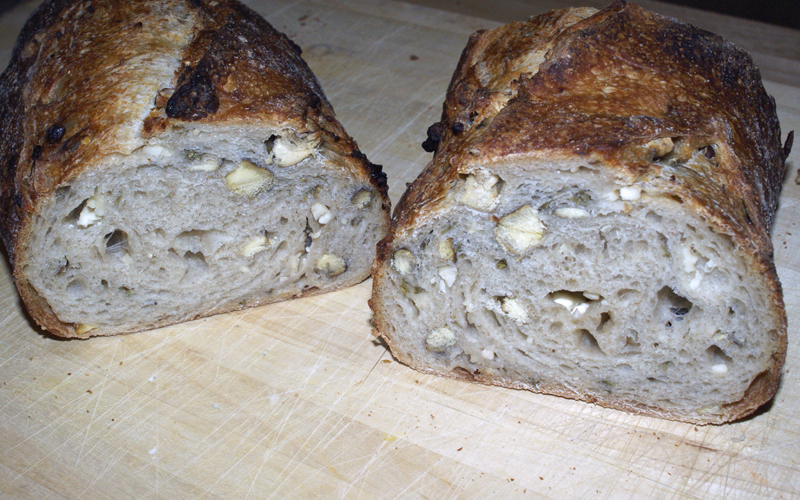I think one of the biggest differences between commercial artisan bakeries, that bake every day, and the amateur that bakes once or even twice a week is how each handles levain day-to-day. From my reading I've gleaned the commercial baker keeps his or her levain (starter) at room temperature, and feeds it on a periodic schedule every 8 or 12 hours. (I'm an amateur, so, experts, please correct me if I'm terribly wrong). on the other hand, most amateurs keep thier starters at refrigerator temperature (~40°F), and feed them once weekly, or less often.
I am less certain how commercial bakers maintain their starters' hydration, I assume, however, that perhaps as little as one day earlier they prepare a chosen amount of their maintained starter by feeding it an amount of flour and water that adjusts its hydration to the target for a days baking. Amateurs keep their maintained starters at a fixed hydration, and, although some amateurs maintain their starters very dry (50%-60%), or very wet (~200%), the usual maintenance hydration is ~100% to ~125%.
The challenge for us amteurs is, "How do I convert an alive, but nearly dormant, relatively cold starter to a formula ready starter, i.e., the correct formula specified starter weight and hydration?"; one might also add, in a reasonably short time.
Some recipes intruct a single feeding, without changing the starter's hydration, followed by a fermentation period--usually 12 hours--and adjusts the dough's flour and water weights to achieve the desired dough hydration. Some amateur bakers convert their maintained starter in one feeding to the target starter weight and hydration, and then feed it an additional one to nine times over a period of one or more days. Both these approaches work, and each have subtle secondary consequences, usually effecting the final bread's flavor. It's not my intent judge the merit of those consequences, merely note they occur.
What I want to do is describe the process I use, explain why I use it, and show some results.
First of all, I have two primary goals for creating formula-ready starters the way I do. One is related to the final dough. I want to achieve a very active starter, strong enough to produce two strong proofs, in moderately short time, i.e., 2-3 hours each; and with sufficient reserve to provide strong oven spring. And, I want to build this formula-ready starter in no more than 24 hours.
The second goal: I want to maintain only a barely necessary amount of starter, e.g., around 200g, 100% hyddration, and fed every two or three weeks.
I've succeeded in reaching both goals using a 3-build approach that triples the amount of starter with each build, and adjusts the hydration by one-third of the difference between the maintained starter's hydration and the formula specified starter hydration.
A couple of definitions, and a little math:
seed starter: the weight of maintained starter that when tripled 3 times yields the formula-specified starter weight.
Intermediate starter: the building starter, i.e. the starter at any time between the beginning of Build 1 and the end of Build 3.
formula-ready starter weight = seed starter weight x (3x3x3) = seed starter weight x 27; therefore:
seed starter weight = formula-ready starter weight/27. But, I always lose some--it sticks to the stirrer, and the its container's walls, so I add a little more, e.g. 20g.
intermediate starter hydration = seed starter hydration +(formula-ready starter hydration - seed starter ready hydration)/3 x # of last build.
An example:
Formula specified starter: 480g, 60% Hydration
Seed starter hydration: 100%
Added to make up loss: 20g
Hence:
Seed starter weight = (480 + 20)/27 = 19g (rounded to nearest whole number)
Intermediate starter's hydration = 100 +(60 - 100)/3 x 1 or 2 or 3 = 100 + (-40)/3 therefore:
during Build 1 the Intermediate starters hydration = 86.7; during build 2 73.3%, and during build 3 60%.
Intermediate starter weights are: Build 1, 55g, Build 2, 167g, and Build 3, 500. (all are rounded to nearest whole gram.)
Now, I'm not going to do the Baker's math to calculate the flour and water weights added each build. I built a spreadsheet to do that for me, but it is possible by hand using Baker's math, and the intermediate starter weights and hydrations.
The results: Below are a series of five photographs that visually document the example above.
Why do it this way?
I reasoned that adding more than twice the weight of the seed starter (or the intermediate starter weights) would dilute the density of the yeast critters beyond a "strong" density, i.e. each build should peak within eight hours or less, Yeast have little or no motility, so after a time, they are surrounded by their waste products: carbon dioxide and alcohol, not food, so production slows down or stops. Stirring , kneading dough, etc. all redistribute yeast, by-products, and food, but I don't want to be burdened with stirring. Furthermore, my goals focus on yeast production, not bacterial growth. (There are other things one can do to develop flavor contributing starters.)
1. Seed Starter: 19g of my refrigerator maintained starter.
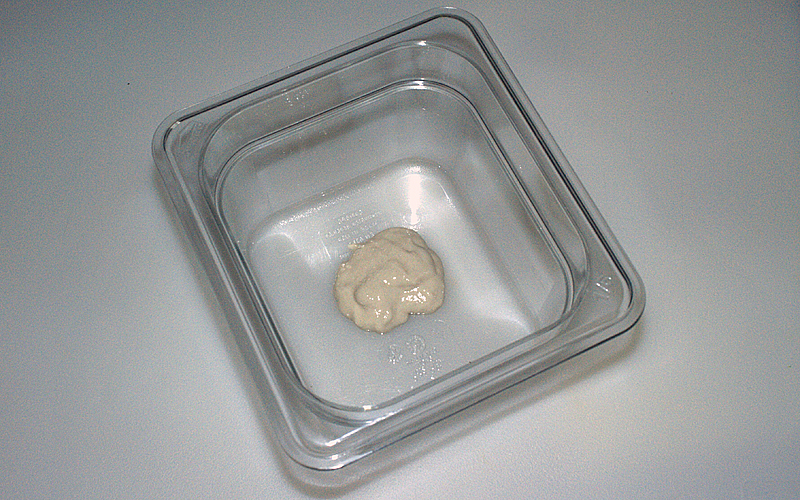
2. Build 2. at its peak 16 hours after starting. I didn't photograph build 1, even at its peak it didn't cover the bottom of the container.
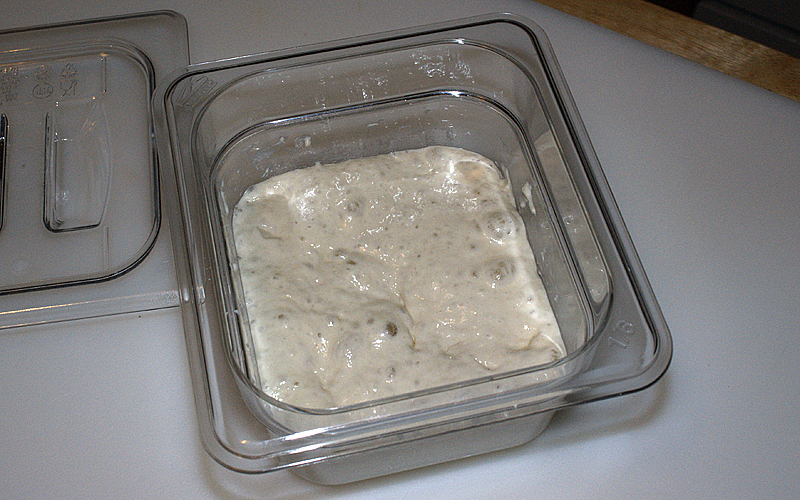
3. Build 3 at zero hour, I'd just added its flour and water additions and spread it out in its container.

4. Build three after only 3 hours (19 hours from the beginning); I consider its growth a good subjective indicator of its strength.

5. Build 3 after 7 hours (23 hours from beginning). You can see evidence it's peaked by the slight deflation around the edges. Immediately after taking this photo I made the dough...
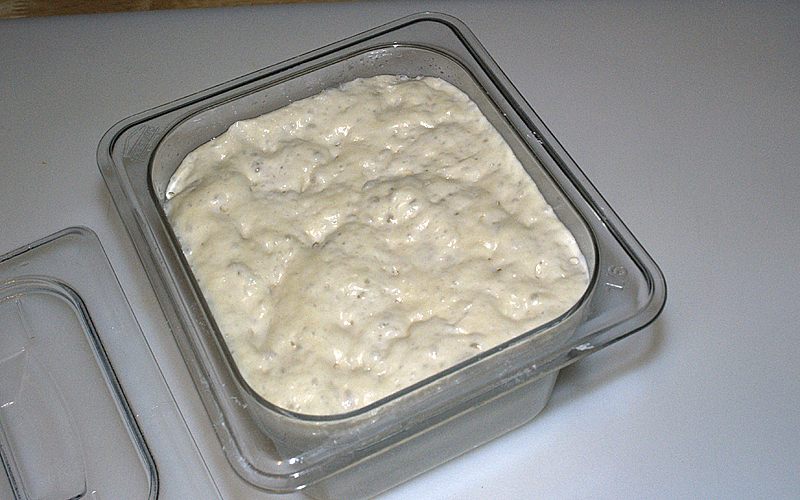
...for this bread. This is D. DiMuzio's San Francisco Sourdough au Levain (firm starter) formula, but I used it for a Thyme-Feta Cheese-Toasted Chestnut vehicle, so it probably doesn't exhibit all the oven spring it might have in an uncluttered dough. Nonetheless, I think it stands a good example of my goal.
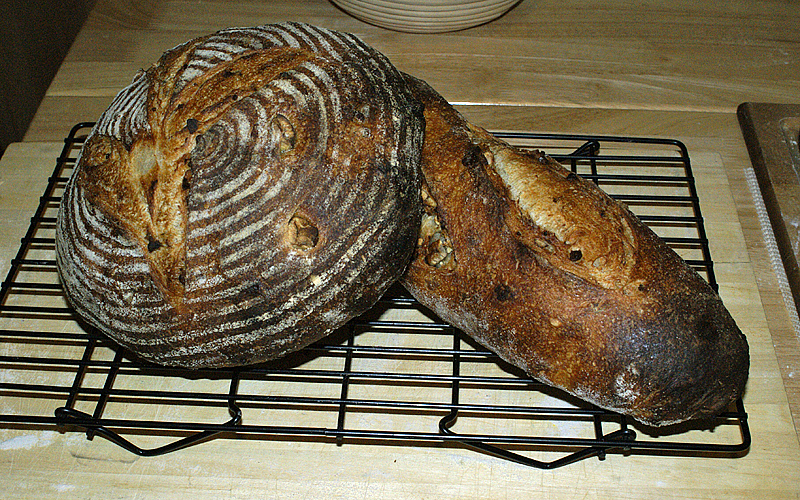
Crumb
